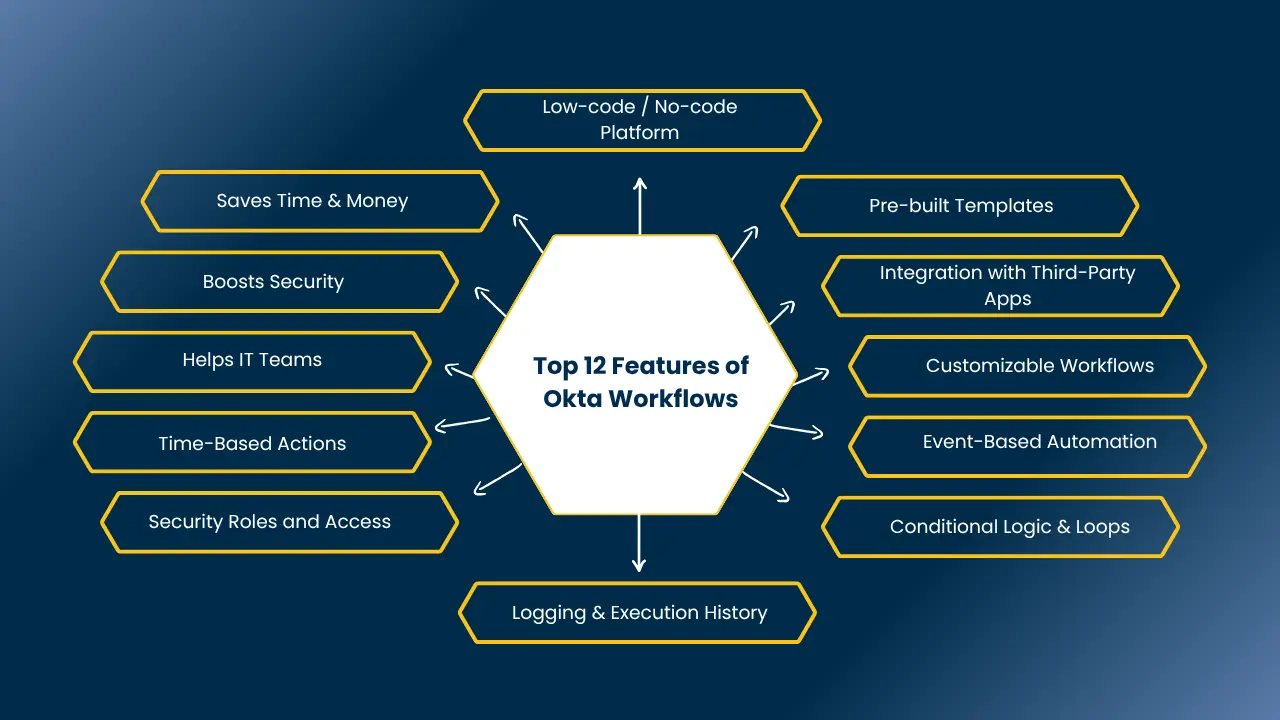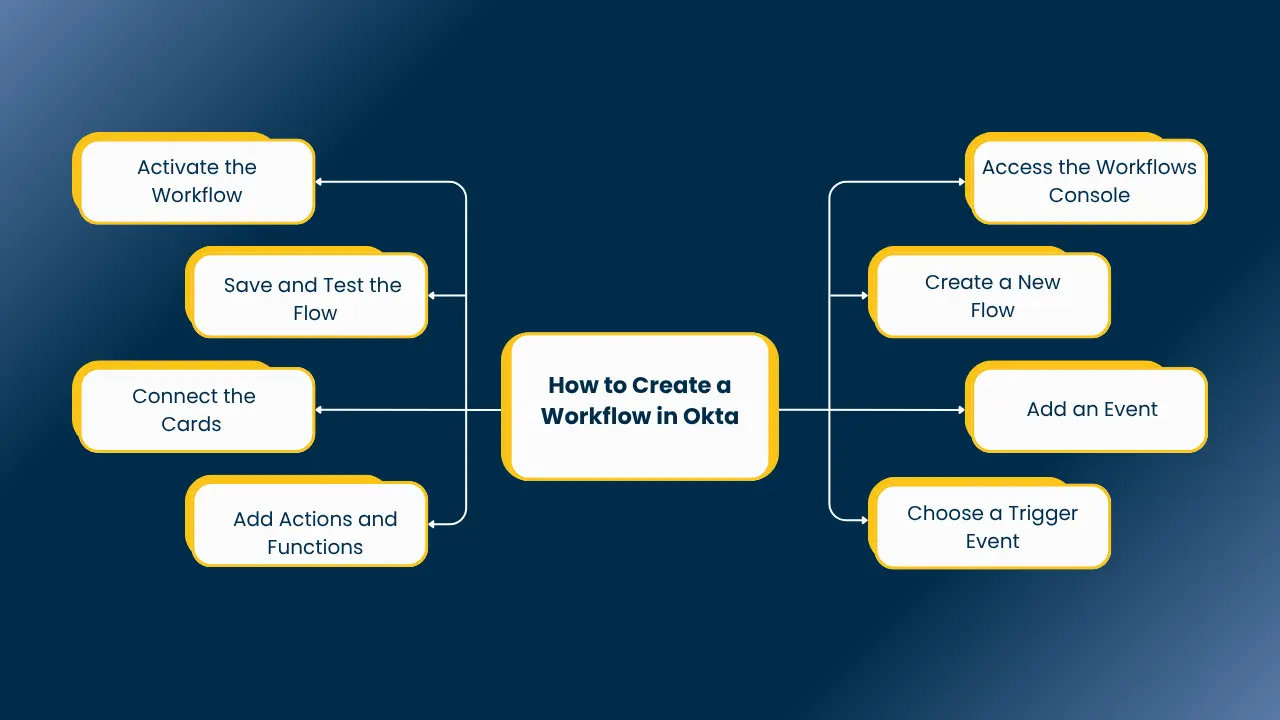Introduction to Okta Workflows for Identity Automation

We all know that in this digital world, organizations want to work faster and safer. There comes Okta workflows. They let them automate the tasks without writing any code. Therefore, it saves times, and reduces errors. So, whether you are in IT or security. Okta workflows can make your job easy and stress free. In this blog, we will discover what Okta workflows are, why are they useful, and how you can start using them? So, if you are new to automation, this is the perfect guide in the world for you.
What are Okta Workflows?
Okta Workflows is a no-code tool that helps you automate identity-related tasks. You don’t need to know programming to use it. With a simple drag-and-drop setup, you can build workflows that manage user access, create accounts, reset passwords, and more. It connects different apps using ready-made connectors, so everything works smoothly together. Okta Workflows is useful for IT teams who want to save time and reduce manual work in user management and security tasks.
Why Use Okta Workflows for Automation?
Okta Workflows helps you save time by automating everyday identity tasks. It makes processes like user onboarding, access control, and offboarding fast and error-free. Let’s look at why more companies are using it.
1. Automates Identity Tasks
- Removes manual work: Okta Workflows handles tasks like adding or removing users, giving access to apps, and updating profiles without human effort.
- Reduces mistakes: Automation means fewer errors and smoother processes across your systems.
- Faster onboarding/offboarding: New employees get access from day one. When someone leaves, their access is removed automatically.
- Simplifies access approvals: Workflows can handle who should get access to what, and when, with built-in approval steps.
2. Improves Security
- Avoids human errors: Automated workflows reduce the chance of security mistakes.
- Faster threat response: If a login looks suspicious, workflows can lock the account or alert your team instantly.
- Better compliance: You can set up regular checks, logs, and reports to meet compliance rules easily.
3. Increases Efficiency
- Cuts IT workload: By removing manual steps, the IT team can focus on bigger tasks.
- Saves time: No need to manually connect apps or update accounts every time something changes.
- Helps employees work faster: Teams don’t have to wait long for access or help from IT.
4. No-Code Platform
- Easy to use: Anyone can build a workflow with the drag-and-drop tool no coding needed.
- Open to all teams: Even non-technical staff can create or manage workflows.
- Custom options: You can build workflows that match your company’s exact needs.
5. Works with Many Tools
- Ready-made connectors: Okta offers connectors for many popular apps like Slack, Zoom, and Google Workspace.
- Build your own: You can create custom connectors if your tool isn’t listed.
Also Read: 10 Best Online Certified Okta Training in Lucknow in 2025
Top 12 Features of Okta Workflows
Okta Workflows comes with powerful features that help automate identity tasks without writing code. It is built to save time, reduce errors, and improve security in your daily IT operations.

1. Low-code / No-code Platform
You can build workflows with a drag-and-drop tool. No need to write scripts. This makes it easy for both IT and non-technical users.
2. Pre-built Templates
Okta offers over 90 templates for tasks like user onboarding, offboarding, and security alerts. You can use them as-is or customize them as needed.
3. Integration with Third-Party Apps
Okta Workflows connects with more than 70 apps like Slack, Zoom, and ServiceNow. You can also create custom connectors for other tools using public APIs.
4. Customizable Workflows
You can design workflows based on your team’s specific needs, such as access requests, approvals, or lifecycle tasks.
5. Event-Based Automation
Workflows can start automatically when an event happens like a new user joining or an app being assigned.
6. Conditional Logic & Loops
You can add if/else conditions and loops to make smart workflows that adjust based on user or system data.
7. Logging & Execution History
Each workflow shows detailed logs for every step. This helps you find and fix issues quickly.
8. Security Roles and Access
You can assign roles like admin or manager to control who can view or change workflows.
9. Time-Based Actions
Set workflows to run at specific times or after delays. This is useful for reminders or time-sensitive tasks.
10. Helps IT Teams
Tasks like provisioning, deprovisioning, and managing user roles are all automated saving hours of manual work.
11. Boosts Security
If something looks suspicious like a login from a new device you can set workflows to respond immediately.
12. Saves Time & Money
By removing manual steps, Okta Workflows helps reduce mistakes, cut costs, and make your team more productive.
Use Cases of Okta Workflows
Okta Workflows helps automate many identity and security tasks across different teams. It is widely used for user management, app integration, and security automation. Let’s explore the most common use cases.
1. User Lifecycle Management
- Onboarding and Offboarding: You can automatically create and deactivate user accounts when employees join or leave the company. This saves time and improves security.
- Account Provisioning and Deprovisioning: Assign or remove access to apps based on user roles. This ensures users have the right access without delays.
- Password Management: Automate password reset flows and session clearing for users who forget passwords or when suspicious activity is detected.
- User Profile Updates: When a user’s details change, Okta Workflows can update their profile in all connected apps automatically.
2. Security Automation
- MFA Management: Set up smart workflows to manage multi-factor authentication. For example, you can allow temporary MFA bypass in special cases.
- Respond to Suspicious Activity: Detect and act on threats like account takeover attempts by suspending accounts or forcing re-login.
- Policy Enforcement: Automatically apply security rules such as password complexity or access restrictions across your apps.
3. Application Integration
- App Onboarding and Offboarding: When someone changes teams, workflows can add or remove them from the right apps.
- Data Sync Across Systems: Keep user data updated across systems by syncing changes from Okta to other apps.
- Custom Integrations: If your app isn’t supported, you can connect to it using Okta Workflows and API calls.
4. Notifications and Reporting
- Lifecycle Notifications: Notify HR or IT teams when important events happen like a user being added or suspended.
- Custom Reports: Create reports to track user logins, app access, or security events using data from Okta APIs.
5. Other Smart Use Cases
- Scheduled Tasks: Run tasks at fixed times, like daily updates or weekly cleanups.
- Event-Driven Automation: Trigger workflows based on user actions or changes in other connected apps.
- Data Transformation: Format or modify data inside workflows before sending it to other tools.
Also Read: What is IAM Engineer Salary in India in Different Countries in 2025
How to Create a Workflow in Okta
Creating a workflow in Okta Workflows is simple. You don’t need to code. You just use the visual console to build steps, connect them, and turn your flow on. Here’s how to do it:

1. Access the Workflows Console
Go to your Okta Admin Console, then open the Workflows section. From there, click on Workflows Console to start.
2. Create a New Flow
Click the “New Flow” button and give your workflow a name. This helps you stay organized as you build more flows.
3. Add an Event
Click on “Add Event” and choose the app where the event will happen like Okta. This is the starting point of your workflow.
4. Choose a Trigger Event
Pick what will trigger the flow. For example, you can choose events like User Created, User Suspended, or others based on your use case.
5. Add Actions and Functions
Use “Add Action” to perform tasks like sending an email or creating a user in another app. Use “Add Function” to process data, add logic (like if/else), or do calculations.
6. Connect the Cards
Link the steps together by dragging connections from one card’s output to another card’s input. This creates the flow of the process.
7. Save and Test the Flow
Click “Save” to store your workflow. Then test it by triggering the event you selected to make sure everything works correctly.
8. Activate the Workflow
When you’re ready, switch “Flow is OFF” to “ON” in the Workflows Console. Your automation is now live.
Okta Workflows Connectors Overview
Okta Workflows connectors help you connect Okta to other applications like Salesforce, Slack, or Google Workspace. With these connectors, you can automate tasks across different systems using a no-code interface.
1. Purpose of Connectors
Connectors allow Okta Workflows to talk to other apps. They help you perform actions like sending alerts in Slack or updating data in Salesforce without manual steps.
2. How Connectors Work
Connectors are made of flows and functions. These define how to interact with another system such as sending data, calling an API, or updating a record.
3. Types of Connectors
- Pre-built Connectors: Ready to use and provided by Okta or trusted partners.
- Custom Connectors: You can build these for your own apps using the Connector Builder.
4. Connector Builder Tool
You don’t need to code. With Connector Builder, you can create custom connectors by just filling out forms and settings.
5. Components of a Connector
Connectors include:
- Inputs and outputs
- Authentication steps
- Parameters for actions
This gives you full control over how the app connects and works.
6. Events and Actions
- Event cards start a workflow when something happens (like a new user is created).
- Action cards perform tasks (like sending an email or adding a user to an app).
7. Deploying Connectors
You can use connectors inside your own company’s Okta setup, or you can submit them to the Okta Integration Network (OIN) so others can use them too.
8. OIN Submission
If your connector meets Okta’s quality standards, they’ll list it in the OIN. This makes it available to other Okta users around the world.
9. Okta Workflows Examples
Some common okta workflows examples using connectors include:
- Sending welcome messages on Slack when a user joins
- Creating leads in Salesforce from new users
- Disabling accounts in Google Workspace when a user leaves
10. Benefits of Using Connectors
- Save time by automating tasks
- Avoid manual errors
- Connect apps easily
- Improve efficiency in your business
11. Common Use Cases
- User lifecycle management
- App access assignment
- Device or profile updates
- Reporting and alerting
12. Compliance (FedRAMP and DoD)
Okta is improving connector support for compliance needs like FedRAMP and DoD IL4. You should always check your system and connector use for compliance requirements.
Read More: How to Be Information Security Manager After cPent Certification
Okta Workflows Pricing & Licensing
Okta Workflows offers flexible pricing plans to suit different business needs. You can start with a free trial or choose from multiple paid options, depending on how many flows and features you need.
1. Free Trial
Okta provides a free trial where you can create up to 5 active flows. However, there are limits on how many times flows can run.
2. Paid Plans
Okta has several pricing tiers:
- Starter Plan: Includes 5 active flows and basic features.
- Light Plan: Offers 50 active flows, full access to all Okta Workflows connectors, templates, and functions and starts at $4 per user/month.
- Medium Plan: Allows 150 active flows and includes all features and priced at $5 per user/month.
- Unlimited Plan: Lets you use unlimited flows with full features and costs $6 per user/month.
3. Key Features Across Plans
- Connectors and Templates: All paid plans include access to pre-built connectors and templates for automation.
- Customization and APIs: You can use custom functions and API calls to build more advanced workflows.
- App Integrations: Connect Okta with apps like Salesforce, Slack, Box, and more.
- Automation Capabilities: Automate user onboarding, offboarding, password resets, and more.
4. Things to Consider
- The number of flows and execution limits depend on the plan you choose.
- Your final cost will vary based on user count, features needed, and support level.
Conclusion
Okta Workflows is a smart way to automate identity and access tasks without writing code. It helps businesses save time, reduce manual errors, and improve security. From onboarding users to responding to threats, it makes daily work easier for IT teams. With flexible pricing, pre-built connectors, and a no-code platform, Okta Workflows is a great choice for companies of all sizes. If you’re planning to learn automation, exploring Okta Workflows certifications and Okta workflows training is a good step forward.
Understand how Orbus can help your career!
Speak with an Expert Now!
FAQ's
What is workflow in Okta?
A workflow in Okta is a set of automated steps that help manage identity tasks like creating users, giving access, or resetting passwords. You can build these steps using a no-code, drag-and-drop tool inside the Okta Workflows platform.
What is Okta Workflow OAuth?
Okta Workflow OAuth is used to connect Okta with third-party apps securely. It uses OAuth tokens to allow workflows to access other systems safely without sharing passwords. This is important for integrations and automation tasks.
How to access Okta Workflows?
To access Okta Workflows, log in to the Okta Admin Console, go to the Workflows section, and open the Workflows Console. From there, you can create, edit, and manage your flows.
What are the three types of Workflows in ServiceNow?
In ServiceNow, the three main types of workflows are:
- Basic Workflows: Simple flows using predefined steps
- Flow Designer Workflows: Built with a drag-and-drop interface
- Custom Workflows: Created using scripting for complex processes
What is the Okta life cycle?
The Okta life cycle refers to how a user's account is managed over time from creation (onboarding), updates (like role changes), to removal (offboarding). Okta Workflows can automate these steps to ensure smooth and secure identity management.




